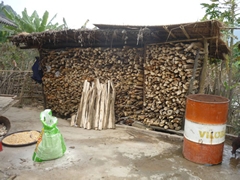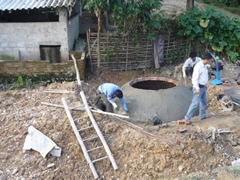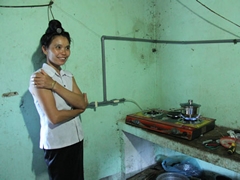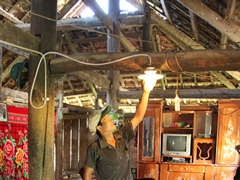- Home
- Technical Cooperation Projects
- Index of Countries
- Asia
- Viet Nam
- Project for Sustainable Forest Management in the Northwest Watershed Area (SUSFORM-NOW)
- Project News
- Reduce negative impacts on the environment, protect forests, and improve life quality by using biogas
Project News
2012-08-05
Reduce negative impacts on the environment, protect forests, and improve life quality by using biogas
(By Nguyen Van Doa, Nua Ngam Commune People’s Committee, Dien Bien Province)
The Project for Sustainable Forest Management in the Northwest Watershed Area (SUSFORM-NOW) has been supporting the construction of biogas plants in the villages in its target sites in order to lessen forest tree cutting for firewood, mitigate negative impacts of livestock raising (untreated animal waste), produce bio-fertilizer for cultivation, and reduce cash expenditure of households.
At Sai Luong (Nua Ngam Commune, Dien Bien District), a village of 46 Thai households, the villagers has been making their livelihoods mainly through agricultural cultivation and small-scale animal rasing. Based on the livelihoods development plan prepared by the villagers, in the last few months, the project has provided both technical knowledge (including training) and support for initial investment to a number of households in the village. Specifically, the project has provided 12 Mong Cai sows for the pig raising group, thousands of freshwater fish fingerlings for the fish raising group, five Lao-type improved cooking stoves, and eight biogas plants in the village.
Initially, the project faced difficulties in introducing and encouraging villagers to use biogas as most of the villagers had no ideas on biogas and saw the support with skepticism. Even after a number of meetings with different presentations and discussion, there was only one household (Quang Van Tuan's) willing to try biogas. The project helped Tuan's household to build a biogas system. This trial PE-type biogas plant quickly showed its effectiveness and became a milestone for introduction of brick-type biogas plant to the villagers.


The interest in biogas among the villagers emerged since then. Among the households interested in biogas use, Cho’s household received the support for construction material for a brick-type biogas plant, which could produce 2 m3 of biogas per day. One month after the completetion, Cho’s family got enough biogas for day-to-day cooking. This means that 10 kg of firewood for cooking, which the family had to collect from surrounding forests, was saved every day. The villagers also noticed another important change in these two pioneering households: the animal raising farms had been free from dirty water, manure, and bad smell because they were collected and used for producing biogas.
The benefits and possitive impacts of two biogas systems created changes in perception and trust among Sai Luong villagers. By May-June, there had been 23 additional households who wished to built biogas plants with the project support. In June 2012, six households completed their brick-type biogas plants with materials provided by the project. These six biogas plants have been operating well to date.
According to these households, they have contributed four million VND (about USD 200) apart from the project support, and they now have biogas not only for their daily cooking, but also for pig feed preparation and even lighting. When these biogas plants operate stably, households can also install additional equipment such as water heaters and heaters. Moreover, women and children of these households now have more free time to relax as they do not have to spend hours to collect firewood from the forests every day. This also means that negative impacts on surounding forests is declining.


- About JICA
- News & Features
- Countries & Regions
- Our Work
- Thematic Issues
- Types of Assistance
- Partnerships with Other Development Partners
- Climate Change / Environmental and Social Considerations
- Evaluations
- Compliance and Anti-corruption
- Science and Technology Cooperation on Global Issues
- Research
- JICA Development Studies Program / JICA Chair
- Support for the Acceptance of Foreign HRs / Multicultural and Inclusive Community
- Publications
- Investor Relations
